Abstract
Nephrotoxicity is an important side effect of aminoglycoside antibiotics, which are used to control infections caused by Gram-negative bacteria. Accumulation of aminoglycosides and phospholipids in the lysosomes is a prominent and early feature of aminoglycoside nephrotoxicity and is characterized histologically by the presence of numerous multilamellar bodies in kidney proximal tubule cells. Previous studies have shown that the drug-induced phospholipid fatty liver in man and animals is due to concentration of certain cationic amphiphilic drugs in lysosomes with inhibition of lysosomal phospholipases. It seemed possible that this mechanism might also explain the elevated levels of phospholipid and increased numbers of multilamellar bodies reported in the kidney cortex in aminoglycoside nephrotoxicity. In this study, subcellular localization of acid phospholipases A and C has been shown to be lysosomal in rat kidney cortex. A soluble lysosomal protein fraction was isolated and found to contain both phospholipase A and phospholipase C activity. Streptomycin did not inhibit the release of fatty acids from [3H]dioleoylphosphatidylcholine. However, amikacin, dibekacin, gentamicin, and tobramycin inhibited both phospholipase A and phospholipase C. Our results suggest that the accumulation of phospholipids in lysosomes of kidney cortex, an early and pervasive feature of acute aminoglycoside nephrotoxicity, is due to inhibition of lysosomal phospholipases.
Full text
PDF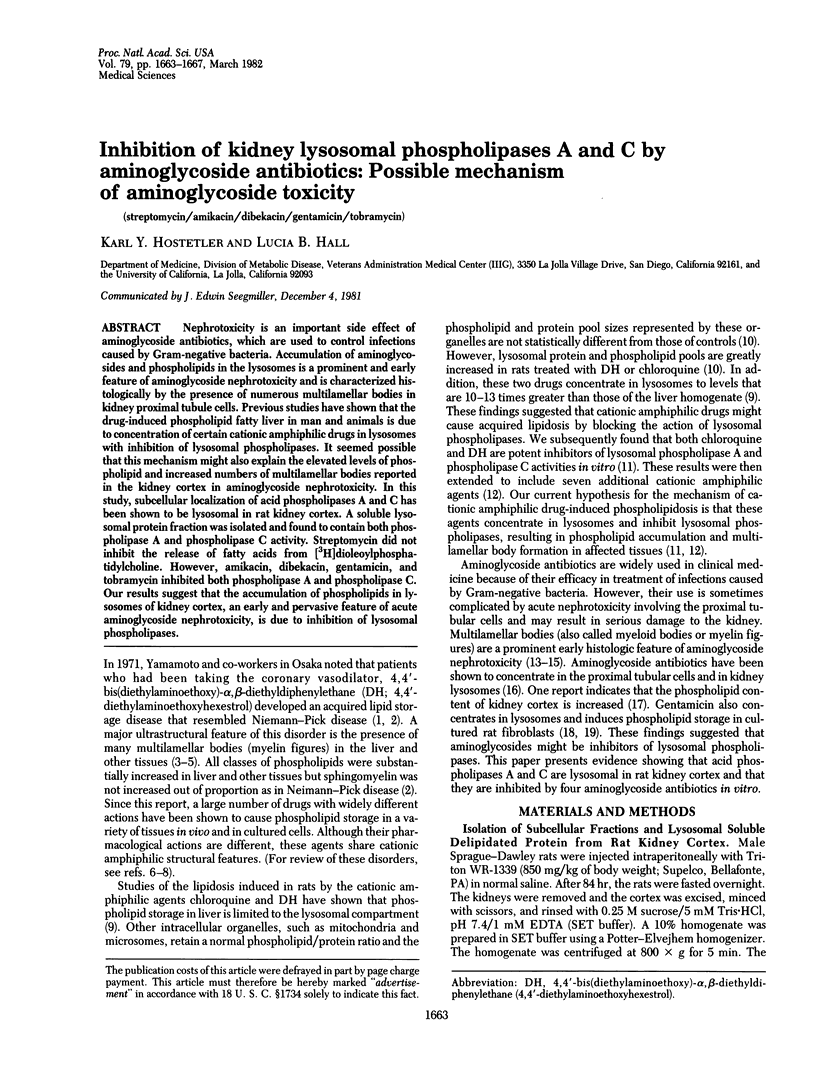
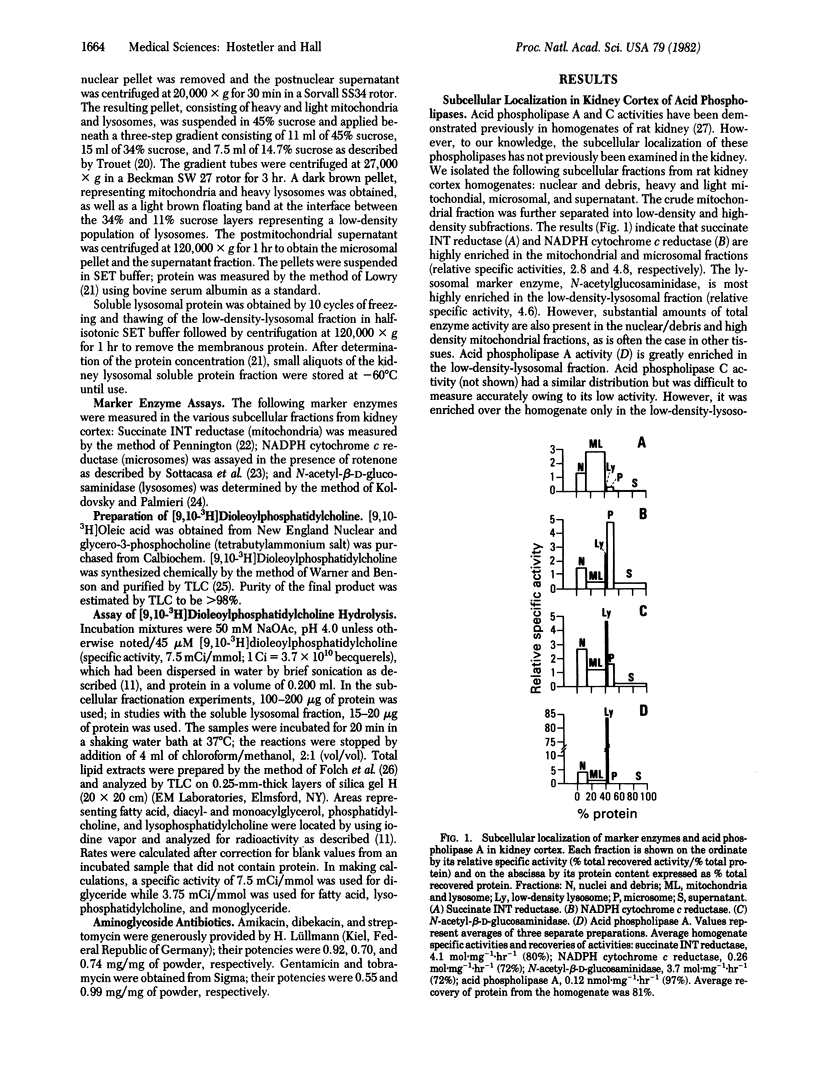
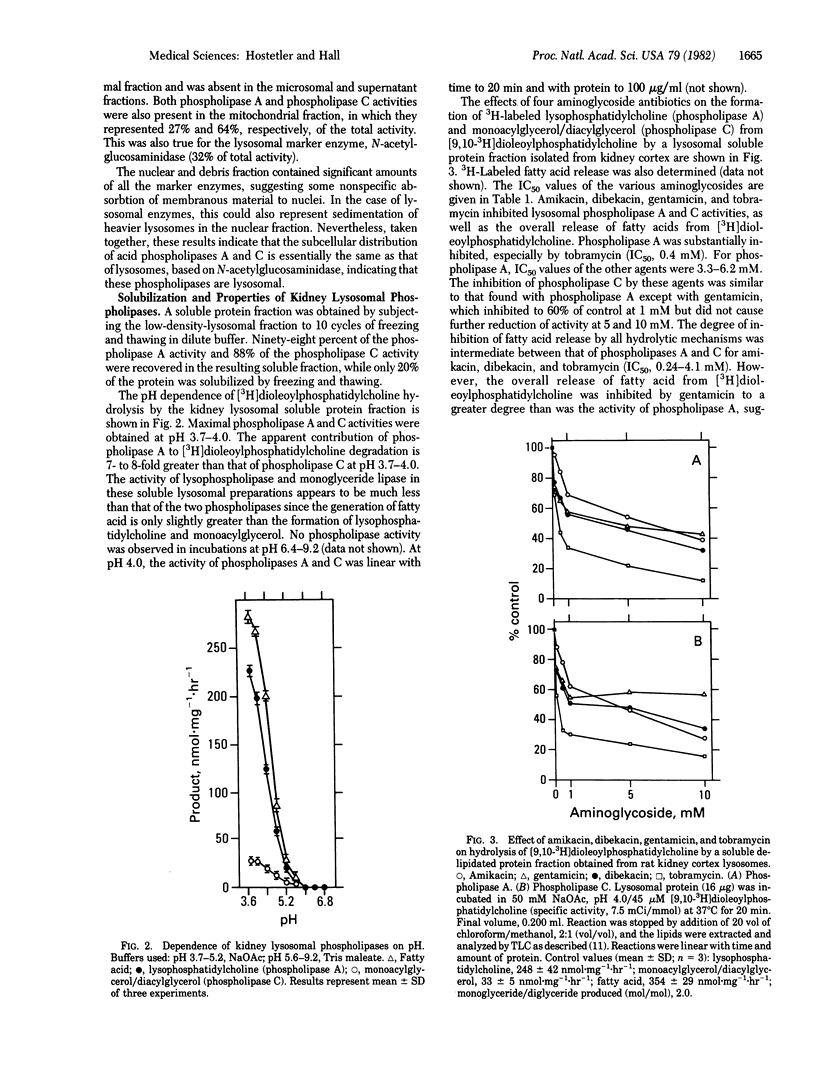
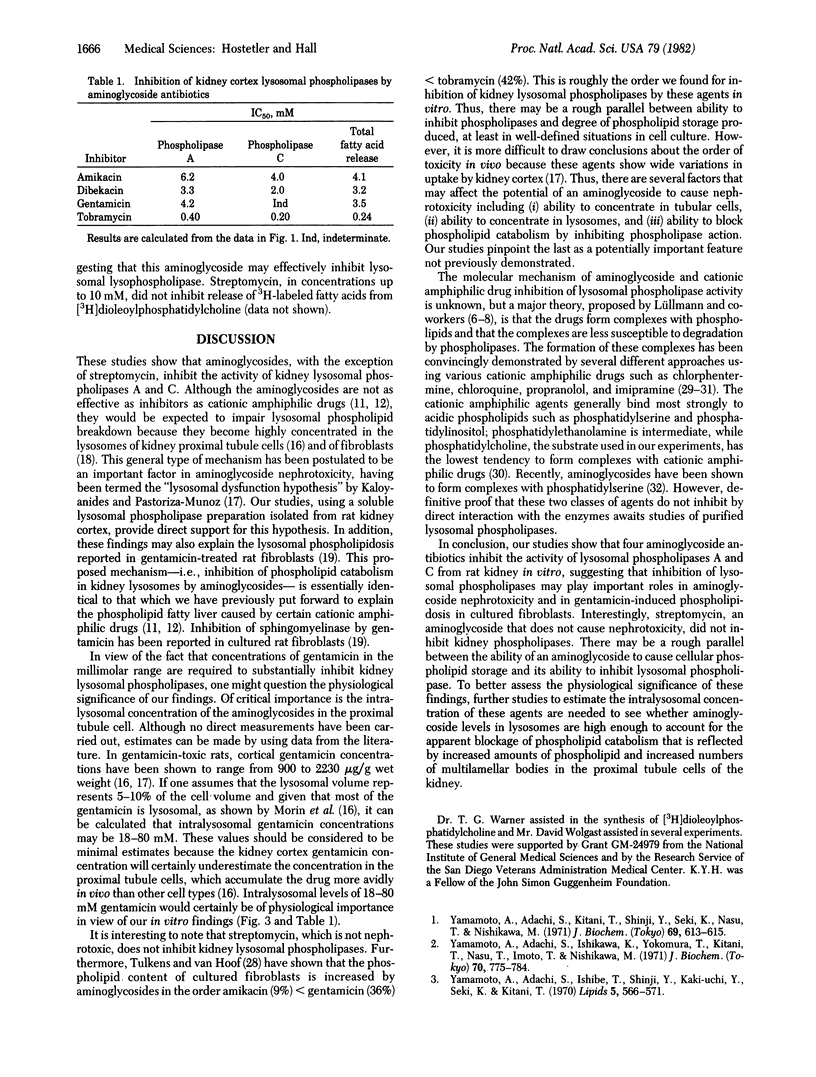
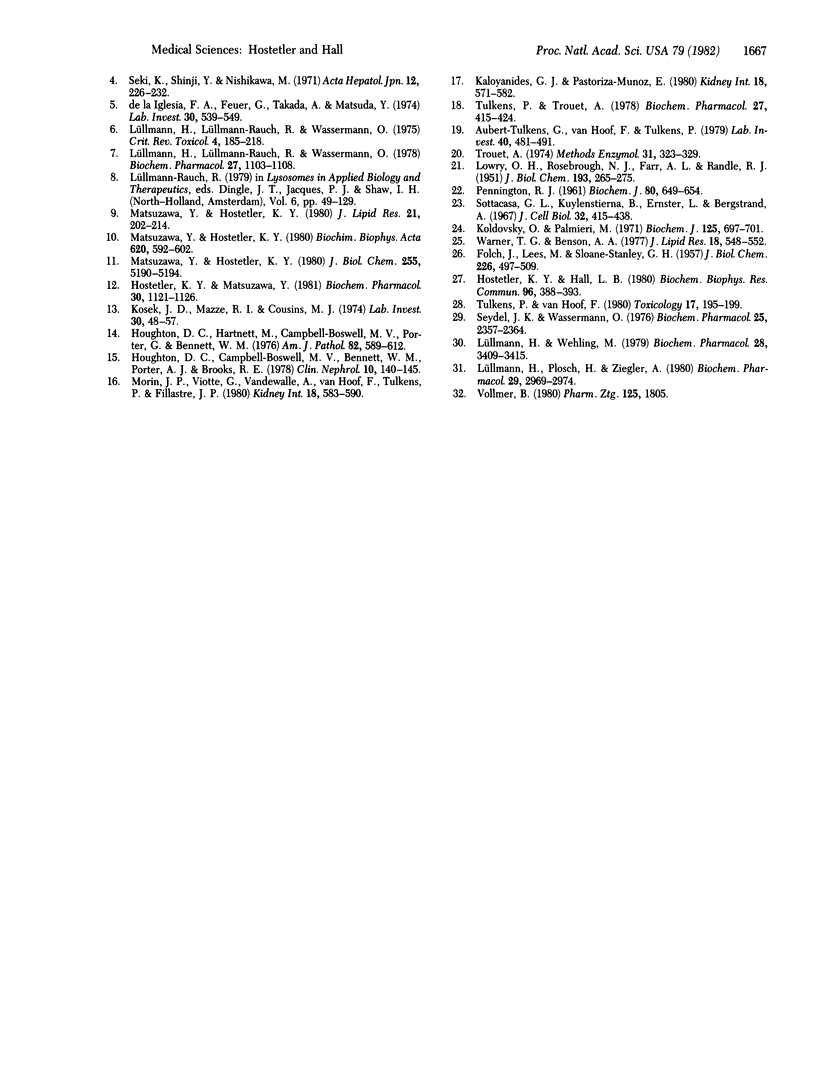
Selected References
These references are in PubMed. This may not be the complete list of references from this article.
- Aubert-Tulkens G., Van Hoof F., Tulkens P. Gentamicin-induced lysosomal phospholipidosis in cultured rat fibroblasts. Quantitative ultrastructural and biochemical study. Lab Invest. 1979 Apr;40(4):481–491. [PubMed] [Google Scholar]
- De la Iglesia F. A., Feuer G., Takada A., Matsuda Y. Morphologic studies on secondary phospholipidosis in human liver. Lab Invest. 1974 Apr;30(4):539–549. [PubMed] [Google Scholar]
- FOLCH J., LEES M., SLOANE STANLEY G. H. A simple method for the isolation and purification of total lipides from animal tissues. J Biol Chem. 1957 May;226(1):497–509. [PubMed] [Google Scholar]
- Hostetler K. Y., Hall L. B. Phospholipase C activity of rat tissues. Biochem Biophys Res Commun. 1980 Sep 16;96(1):388–393. doi: 10.1016/0006-291x(80)91227-9. [DOI] [PubMed] [Google Scholar]
- Hostetler K. Y., Matsuzawa Y. Studies on the mechanism of drug-induced lipidosis. Cationic amphiphilic drug inhibition of lysosomal phospholipases A and C. Biochem Pharmacol. 1981 May 15;30(10):1121–1126. doi: 10.1016/0006-2952(81)90451-2. [DOI] [PubMed] [Google Scholar]
- Houghton D. C., Campbell-Boswell M. V., Bennett W. M., Porter G. A., Brooks R. E. Myeloid bodies in the renal tubules of humans: relationship to gentamicin therapy. Clin Nephrol. 1978 Oct;10(4):140–145. [PubMed] [Google Scholar]
- Houghton D. C., Hartnett M., Campbell-Boswell M., Porter G., Bennett W. A light and electron microscopic analysis of gentamicin nephrotoxicity in rats. Am J Pathol. 1976 Mar;82(3):589–612. [PMC free article] [PubMed] [Google Scholar]
- Kaloyanides G. J., Pastoriza-Munoz E. Aminoglycoside nephrotoxicity. Kidney Int. 1980 Nov;18(5):571–582. doi: 10.1038/ki.1980.175. [DOI] [PubMed] [Google Scholar]
- Koldovský O., Palmieri M. Cortisone-evoked decrease of acid -galactosidase, -glucuronidase, N-acetyl- -glucosaminidase and arylsulphatase in the ileum of suckling rats. Biochem J. 1971 Dec;125(3):697–701. doi: 10.1042/bj1250697. [DOI] [PMC free article] [PubMed] [Google Scholar]
- Kosek J. C., Mazze R. I., Cousins M. J. Nephrotoxicity of gentamicin. Lab Invest. 1974 Jan;30(1):48–57. [PubMed] [Google Scholar]
- LOWRY O. H., ROSEBROUGH N. J., FARR A. L., RANDALL R. J. Protein measurement with the Folin phenol reagent. J Biol Chem. 1951 Nov;193(1):265–275. [PubMed] [Google Scholar]
- Lüllmann H., Lüllmann-Rauch R., Wassermann O. Drug-induced phospholipidoses. II. Tissue distribution of the amphiphilic drug chlorphentermine. CRC Crit Rev Toxicol. 1975 Nov;4(2):185–218. doi: 10.1080/10408447509164014. [DOI] [PubMed] [Google Scholar]
- Lüllmann H., Lüllmann-Rauch R., Wassermann O. Lipidosis induced by amphiphilic cationic drugs. Biochem Pharmacol. 1978;27(8):1103–1108. doi: 10.1016/0006-2952(78)90435-5. [DOI] [PubMed] [Google Scholar]
- Lüllmann H., Plösch H., Ziegler A. Ca replacement by cationic amphiphilic drugs from lipid monolayers. Biochem Pharmacol. 1980 Nov 1;29(21):2969–2974. doi: 10.1016/0006-2952(80)90046-5. [DOI] [PubMed] [Google Scholar]
- Lüllmann H., Wehling M. The binding of drugs to different polar lipids in vitro. Biochem Pharmacol. 1979 Dec 1;28(23):3409–3415. doi: 10.1016/0006-2952(79)90080-7. [DOI] [PubMed] [Google Scholar]
- Matsuzawa Y., Hostetler K. Y. Effects of chloroquine and 4,4'-bis(diethylaminoethoxy)alpha, beta-diethyldiphenylethane on the incorporation of [3H]glycerol into the phospholipids of rat liver lysosomes and other subcellular fractions, in vivo. Biochim Biophys Acta. 1980 Dec 5;620(3):592–602. doi: 10.1016/0005-2760(80)90151-4. [DOI] [PubMed] [Google Scholar]
- Matsuzawa Y., Hostetler K. Y. Inhibition of lysosomal phospholipase A and phospholipase C by chloroquine and 4,4'-bis(diethylaminoethoxy) alpha, beta-diethyldiphenylethane. J Biol Chem. 1980 Jun 10;255(11):5190–5194. [PubMed] [Google Scholar]
- Matsuzawa Y., Hostetler K. Y. Studies on drug-induced lipidosis: subcellular localization of phospholipid and cholesterol in the liver of rats treated with chloroquine or 4,4'-bis (diethylaminoethoxy)alpha, beta-diethyldiphenylethane. J Lipid Res. 1980 Feb;21(2):202–214. [PubMed] [Google Scholar]
- Morin J. P., Viotte G., Vandewalle A., Van Hoof F., Tulkens P., Fillastre J. P. Gentamicin-induced nephrotoxicity: a cell biology approach. Kidney Int. 1980 Nov;18(5):583–590. doi: 10.1038/ki.1980.176. [DOI] [PubMed] [Google Scholar]
- PENNINGTON R. J. Biochemistry of dystrophic muscle. Mitochondrial succinate-tetrazolium reductase and adenosine triphosphatase. Biochem J. 1961 Sep;80:649–654. doi: 10.1042/bj0800649. [DOI] [PMC free article] [PubMed] [Google Scholar]
- Seydel J. K., Wassermann O. NMR-studies on the molecular basis of drug-induced phospholipidosis--II. Interaction between several amphiphilic drugs and phospholipids. Biochem Pharmacol. 1976 Nov 1;25(21):2357–2364. doi: 10.1016/0006-2952(76)90028-9. [DOI] [PubMed] [Google Scholar]
- Sottocasa G. L., Kuylenstierna B., Ernster L., Bergstrand A. An electron-transport system associated with the outer membrane of liver mitochondria. A biochemical and morphological study. J Cell Biol. 1967 Feb;32(2):415–438. doi: 10.1083/jcb.32.2.415. [DOI] [PMC free article] [PubMed] [Google Scholar]
- Trouet A. Isolation of modified liver lysosomes. Methods Enzymol. 1974;31:323–329. doi: 10.1016/0076-6879(74)31034-8. [DOI] [PubMed] [Google Scholar]
- Tulkens P., Trouet A. The uptake and intracellular accumulation of aminoglycoside antibiotics in lysosomes of cultured rat fibroblasts. Biochem Pharmacol. 1978 Feb 15;27(4):415–424. doi: 10.1016/0006-2952(78)90370-2. [DOI] [PubMed] [Google Scholar]
- Tulkens P., Van Hoof F. Comparative toxicity of aminoglycoside antibiotics towards the lysosomes in a cell culture model. Toxicology. 1980;17(2):195–199. doi: 10.1016/0300-483x(80)90094-3. [DOI] [PubMed] [Google Scholar]
- Warner T. G., Benson A. A. An improved method for the preparation of unsaturated phosphatidylcholines: acylation of sn-glycero-3-phosphorylcholine in the presence of sodium methylsulfinylmethide. J Lipid Res. 1977 Jul;18(4):548–552. [PubMed] [Google Scholar]
- Yamamoto A., Adachi S., Ishibe T., Shinji Y., Kaki-Uchi Y., Seki K. I., Kitani T. Accumulation of acidic phospholipids in a case of hyperlipidemia with hepatosplenomegaly. Lipids. 1970 Jun;5(6):566–571. doi: 10.1007/BF02532747. [DOI] [PubMed] [Google Scholar]
- Yamamoto A., Adachi S., Ishikawa K., Yokomura T., Kitani T. Studies on drug-induced lipidosis. 3. Lipid composition of the liver and some other tissues in clinical cases of "Niemann-Pick-like syndrome" induced by 4,4'-diethylaminoethoxyhexestrol. J Biochem. 1971 Nov;70(5):775–784. doi: 10.1093/oxfordjournals.jbchem.a129695. [DOI] [PubMed] [Google Scholar]
- Yamamoto A., Adachi S., Kitani T., Shinji Y., Seki K. Drug-induced lipidosis in human cases and in animal experiments. Accumulation of an acidic glycerophospholipid. J Biochem. 1971 Mar;69(3):613–615. [PubMed] [Google Scholar]


